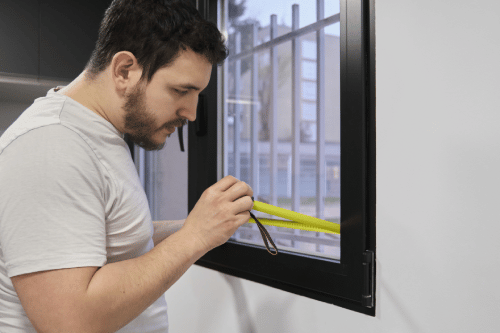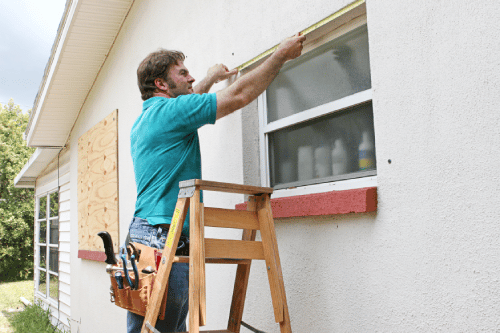December 05, 2022
Are you a homeowner who’s found yourself with cracked glass, leaking window frames, and/or sky-high utility bills? Sounds like it’s time to figure out how to measure your windows for replacement. Whether you will be ordering new windows online or hiring a professional, measuring your windows correctly is crucial to ensure you get the right fit. Luckily, it’s simply a matter of following the right guide. In this piece, we will walk you through how to measure your windows so that you can get those replacements in ASAP and stress-free. 





Window measuring guide
Your basic window measurements will always start with three checks:- Square check
- Window width
- Window height
Square check
Be sure to always start with the square check. Warning: if your frame doesn’t pass this test, then a window replacement is out of the question and you’ll likely need to construct a new window. The square check determines whether your existing frame measures at 90-degree angles in all four corners. To do this, measure diagonally from the top right corner to the bottom left corner and then from the top left corner to the bottom right corner. If those two measurements are more than ¼ inch apart…call in the professionals. It may be time for a new window frame. Once you are sure your window frame isn’t warped, you’ll want to measure width and height.Pro-tip: Industry standards dictate that width always comes before height. So when you’re talking to the professionals, make sure you’ve written your measurements down in that order!
How to measure window width
Measuring window width is a little more complex than one might expect. You’re going to take three measurements and use the smallest one.- Bottom measurement: raise the window and measure horizontally from left to right jamb. You’ll include the frame in which the glass sits, but not the trim/jambs themselves.
- Middle measurement: close the window and measure horizontally from left to right jamb in the middle of the window.
- Top measurement: measure horizontally from left to right jamb at the top of the window.

How to measure window height
Measuring window height is very similar to measuring window width. Once again, you’ll take three measurements and then use the smallest one to order your perfect window. Measuring from the sill (bottom fixed-frame piece) to the head (top fixed-frame piece), measure vertically once on the left, in the center, and on the right. Then, take the smallest number and use it as your height measurement when looking at window sizes.Special window measurements
Now let’s take a look at a few non-standard measurements. Any window is measurable, some simply take a bit more know-how. Here are a few of the most common special window measurements.How to measure window depth
To measure window depth, simply measure the distance between the inside and the outside of the frame on either the top or bottom of the window. It’s a small and easy measurement, but it can be an essential one. Depth isn’t a standard measurement included on most replacement window products because 9 out of 10 times, it’s not essential for a safe fit. However, if you’re looking to replace a window in a structure like a modular home, it’s worth checking the depth. Some modern homes have extremely narrow frames and require specific types of replacements. If the distance from front trim to back trim is less than 3¼ inches, you’ll need to purchase a custom replacement.
How to measure double-hung windows
Double-hung windows sound more intimidating than single-hung, but your process will be nearly identical. The only difference is that you’ll use the standard measuring process twice. The most important thing to remember when it comes to double-hung windows is to individually measure each pane. Never assume both top and bottom are identical—you may end up with panes that don’t fit evenly!
How to measure for storm windows
Storm windows measure almost identically to standard single-hung windows. The only difference is that you won’t open the window to measure for width; you’ll keep it closed for all three measurements. When measuring storm windows, it’s extra critical to check for square fit. The last thing you want between you and dangerous weather is a faulty window frame!How to measure bay or bow windows
Bay and bow windows are gorgeous in your home—but they’re a bit more complex to measure. For these types of windows, you’ll need the basic width x height measurements for each window panel. You’ll also need those same measurements for the width and height of the entire window area. At the end of measuring, you should have eight numbers:- Right panel (WxH)
- Center panel (WxH)
- Left panel (WxH)
- Entire window (WxH)
How to measure for window screen replacements
Window screen replacements are thankfully much more straightforward than window panes. For window screen measurements, all you’ll need is a single width x height number. We recommend adding about ⅛ inch to your screen measurements before purchasing, though. Different screens may fit differently, depending on the brand. Adding an extra ⅛ inch assures a snug fit.
Replacing a window with a different style
Not every window replacement is motivated by damage. Often, proactive homeowners will upgrade their windows for aesthetic reasons and/or energy efficiency! When changing window styles, you’ll have an opportunity to open up your space in a whole new way, but there are a few things to track:- Is there anything permanent outside the window? Many standard windows open up and down by sliding, but casement windows (which crank open on a side hinge) can be a lovely way to add a bit of flair—if there’s room. Just because a window fits your frame doesn’t mean it fits the entire window area. If you’re switching to a window that opens out of or into your home, make sure you know how much space you’ll need for the swinging panes.
- Will a different type of glass affect the temperature in a negative way? One of the key jobs of windows is to regulate internal temperature. However, depending on the type of glass, items next to windows can have very different experiences. If you’re replacing a window near old furniture or growing plants, the type and thickness of glass may impact their sun and temperature exposure.
How to order replacement windows
There are two ways to order windows depending on whether you’re looking for professional installation or taking the DIY route. If you’re in the DIY camp, the best way to order your windows is from a reliable home improvement store like Lowe’s or Home Depot. Not only do they carry multiple brands, but you can also visit their stores to see different types of windows in person and decide on your preferred style and glass type.Of course, we recommend using the professional approach. DIY is fantastic for people who know what they’re doing, but for most of us, it’s best to leave a delicate operation like window installation to the experts. Windows protect your home from burglary, dust, weather, insects, and mold. A poorly selected or installed window isn’t just an inconvenience—it can lead to some pretty expensive consequences.
When you work with a professional window company, you’ll have the peace of mind that comes from knowing your measurements are accurate, your replacement is up to code, and your windows are under warranty.

How much do replacement windows cost?
Windows aren’t all created equally, so the cost of replacements varies quite a bit based on:- Window style (double hung, sliding, vent, etc)
- Window size
- Window material (vinyl, wood, etc)
- State of the window frame (and whether or not frame replacement is also required)
- Type of glass (single-pane, double-pane, laminated, etc)
- The age of your home and any age-related restrictions by local law



